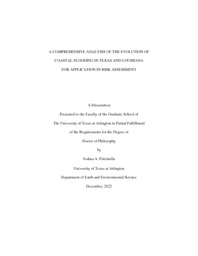
ATTENTION: The works hosted here are being migrated to a new repository that will consolidate resources, improve discoverability, and better show UTA's research impact on the global community. We will update authors as the migration progresses. Please see MavMatrix for more information.
Show simple item record
| dc.contributor.advisor | Winguth, Arne | |
| dc.creator | Pulcinella, Joshua | |
| dc.date.accessioned | 2023-01-26T16:14:16Z | |
| dc.date.available | 2023-01-26T16:14:16Z | |
| dc.date.created | 2022-12 | |
| dc.date.issued | 2022-12-09 | |
| dc.date.submitted | December 2022 | |
| dc.identifier.uri | http://hdl.handle.net/10106/31021 | |
| dc.description.abstract | Coastal communities of the northern Gulf of Mexico have historically been at risk of flooding from tropical cyclone induced storm surge and extreme precipitation. Relative sea level rise resulting from a combination of increasing global mean sea level and regional subsidence presents an escalating threat that requires a comprehensive assessment of changing flood risks for the area. This study examines how coastal flooding events are changing and focuses on the future risks to communities and infrastructure in Texas and Louisiana. Utilizing historic tide gauge observations, tropical cyclone records, and associated storm tide data, the frequency, duration, and magnitude of events exceeding existing flood threshold levels are quantified, return periods estimated, correlations with climate oscillations tested, and trends analyzed.
To assess forecasting relative sea level rise, a seasonal autoregressive integrated moving average (SARIMA) model based on raw tide gauge observations is compared to probabilistic projections based on background subsidence rates, global climate models and anthropogenic emissions scenarios. Projections are utilized to map inundation under a range of future scenarios for mean high tide and added to SLOSH storm surge model output under current sea level to map future storm tide inundation under multiple hurricane categories. Probabilistic projections appear to be more suitable for use in risk assessments than SARIMA modeling as they forecast a range of possible sea level rise acceleration scenarios that address the uncertainties inherent in the climate system, climate models, and anthropogenic emissions, while SARIMA lacks the ability to model acceleration.
Inundation mapping using probabilistic scenarios revealed the impacts from relative sea level on mean high tide flooding risk will be seen in the lowest elevations as early as 2040 under all scenarios and the addition of sea level rise to modeled storm surge increases the area of inundation farther inland effecting populations and infrastructure not previously threatened. Additionally, non-tidal residuals associated with storms were found to be the primary influence on flood threshold exceedance over the last 40 years. Estimated peak surge return periods based on 30-year averages from 1900-2020 suggest an increase to the 100-year peak surge of ~2.5 meters. This study found relative sea level rise, rather than changes in tropical cyclone climatology or climate oscillations, is the key factor contributing to more frequent, longer lasting, and greater magnitude coastal flooding events observed in the record and will continue to present an increasing risk as global temperature rises. Moreover, relative sea level rise is increasing the probability of high tide, or nuisance, flooding not associated with storms and impacts that were historically rare are becoming more common and lasting longer, particularly at locations with higher tidal ranges.
Results suggest that coastal flood risk assessments can be improved to include the enhanced risks associated with accelerating relative sea level rise rather than relying on historic observations. These improvements include using localized sea level projections that reflect varying subsidence rates, estimating future surge return periods based on observed changes, accounting for previously rare events such as high tide flooding and inland storm surge inundation, and recognizing social vulnerability as an additional risk. | |
| dc.format.mimetype | application/pdf | |
| dc.language.iso | en_US | |
| dc.subject | Relative sea level rise | |
| dc.subject | High tide flooding | |
| dc.subject | Storm surges | |
| dc.title | A Comprehensive Analysis of the Evolution of Coastal Flooding in Texas and Louisiana for Application in Risk Assessment | |
| dc.type | Thesis | |
| dc.date.updated | 2023-01-26T16:14:16Z | |
| thesis.degree.department | Earth and Environmental Sciences | |
| thesis.degree.grantor | The University of Texas at Arlington | |
| thesis.degree.level | Doctoral | |
| thesis.degree.name | Doctor of Philosophy in Earth and Environmental Science | |
| dc.type.material | text | |
Files in this item
- Name:
- PULCINELLA-DISSERTATION-2022.pdf
- Size:
- 12.93Mb
- Format:
- PDF
This item appears in the following Collection(s)
Show simple item record


